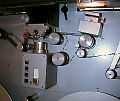Photo gallery
- Robert Bosch in 1888
- Intermediate film system for first Remote Truck (1936) - movie camera; 2 - film processor; 3 - washing bath; 4 - film drying compartment; 5 - telecine; 6 - monitor; 7 - video output; 8 - sewage; 9 - plumbing.
- BOSCH Quad VTR Model BCM 40
- Fernseh GmbH Telecine with a Pantason 16 mm film projector in 1956
- Orthikon Camera in 1957
- Fernseh GmbH TV recorder at MTV Studio in 1958 in Budapest
- BCN 51 Fernseh VTR
- Bosch Fernseh FDL 60 Telecine Film Deck and Lens Gate
- FRP 60 Control Panel, Bosch Fernesh
- BCN 52 VTR
- BCN 20 VTR with "L unit" playback with TBC.
- BCN 20 VTR hand held VTR recorder.
- BCN 20 VTR deck
- BCH-1000 HDTV B VTR
- QUATERCAM BCF studio VTR (Lineplex system)
- D1 DCR 500 VTR
- BOSCH KCK-40
- KCM-125 SDTV camera with a Schneider Optics Lens
- KOD 3 television studio camera from 1958 in the Museum Hamburg
- Bosch Fernseh HQ_Darmstadt, Germany
- Bosch Fernseh HQ street sign Darmstadt Germany
- Fernseh Inc. Logo
- Bosch Video Corp. logo
- D6 VTR Tape Deck
- D6 VTR Scanner, removed
- Inside a D6 VTR Tape Deck
- D6 VTR full unit
- SDC-2000 Spirit DataCine Film Deck
- Quadra Telecine Film Deck
- SDC-2000 Spirit DataCine Functional Control Panel-FCP
- Spirit Datacine 4k with the doors closed
- Spirit Datacine 4k with the doors open.jpg
- A Shadow Telecine in a color correction suite.
- Shadow Telecine
- GCP for a Spirit Datacine
- Scanity Film Deck
- Cinelicious Scanity 4k and work station
- Bosch Logo





































